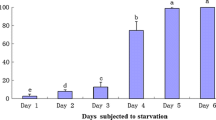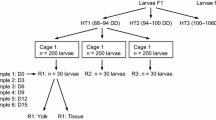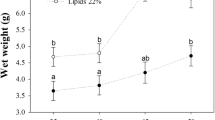Abstract
Metamorphosis in the Chilean oyster Ostrea chilensis was complete 36 h after release of the larvae, when 100% of the individuals showed edge growth of the dissoconch. The size of the larval shell did not change during metamorphosis, although the total dry weight of the larva decreased considerably. During this period, when the gill ciliature was undeveloped and the oyster therefore unable to feed, energy demands were met by biochemical reserves retained from the larval phase. Proteins contributed the largest quantity of energy to the metamorphosing oyster, 69.3% of the total expended, whereas lipids supplied 24.3% and carbohydrates only 6.4%. The process of metamorphosis consumed 64.5% of the energy reserves held by the pediveliger at the time of release. When metamorphosis was complete, growth began and tissue reserves were replenished, protein and carbohydrate accumulating rapidly early in the juvenile stage.
Similar content being viewed by others
Author information
Authors and Affiliations
Additional information
Received: 26 December 1997 / Accepted: 8 July 1998
Rights and permissions
About this article
Cite this article
Videla, J., Chaparro, O., Thompson, R. et al. Role of biochemical energy reserves in the metamorphosis and early juvenile development of the oyster Ostrea chilensis. Marine Biology 132, 635–640 (1998). https://doi.org/10.1007/s002270050428
Issue Date:
DOI: https://doi.org/10.1007/s002270050428




